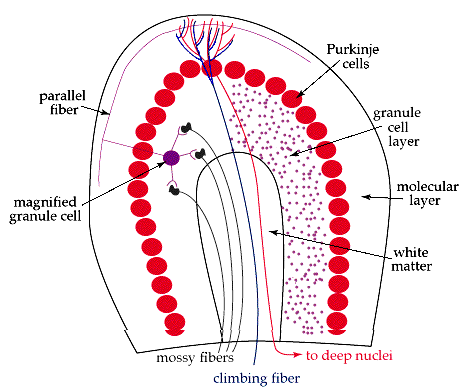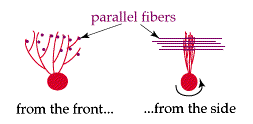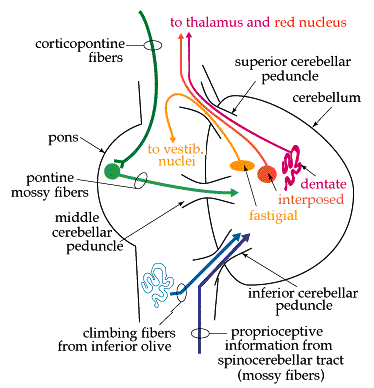|
|
Cat cerebellum, sagittal section |
Single folium, enlarged |
A special thanks to The Washington University School of Medicine
CEREBELLUM
The cerebellum is involved in the coordination
of movement. A simple way to look at its purpose is that it compares what you
thought you were going to do (according to motor cortex) with what is actually
happening down in the limbs (according to proprioceptive feedback), and corrects
the movement if there is a problem. The cerebellum is also partly responsible
for motor learning, such as riding a bicycle. Unlike the cerebrum, which works
entirely on a contralateral basis, the cerebellum works ipsilaterally.
The cerebellum ("little brain") has
convolutions similar to those of cerebral cortex, only the folds are much
smaller. Like the cerebrum, the cerebellum has an outer cortex, an inner white
matter, and deep nuclei below the white matter.
|
|
Cat cerebellum, sagittal section |
Single folium, enlarged |
If we enlarge a single fold of cerebellum, or
a folium, we can begin to see the organization of cell types. The
outermost layer of the cortex is called the molecular layer, and is
nearly cell-free. Instead it is occupied mostly by axons and dendrites. The
layer below that is a monolayer of large cells called Purkinje cells,
central players in the circuitry of the cerebellum. Below the Purkinje cells is
a dense layer of tiny neurons called granule cells. Finally, in the
center of each folium is the white matter, all of the axons traveling into and
out of the folia.
These cell types are hooked together in
stereotypical ways throughout the cerebellum.

| Mossy fibers are one of two main sources of input to the cerebellar cortex. A mossy fiber is an axon terminal that ends in a large, bulbous swelling. These mossy fibers enter the granule cell layer and synapse on the dendrites of granule cells (right); in fact the granule cells reach out with little "claws" to grasp the terminals. The granule cells then send their axons up to the molecular layer, where they end in a T and run parallel to the surface. For this reason these axons are called parallel fibers. The parallel fibers synapse on the huge dendritic arrays of the Purkinje cells. |
|
| However, the individual parallel fibers are not a strong drive to the Purkinje cells. The Purkinje cell dendrites fan out within a plane, like the splayed fingers of one hand. If you were to turn a Purkinje cell to the side, it would have almost no width at all. The parallel fibers run perpendicular to the Purkinje cells, so that they only make contact once as they pass through the dendrites. | |

Although each parallel fiber touches each Purkinje cell only once, the thousands of parallel fibers working together can drive the Purkinje cells to fire like mad.
The second main type of input to the folium is
the climbing fiber. The climbing fibers go straight to the Purkinje cell
layer and snake up the Purkinje dendrites, like ivy climbing a trellis. Each
climbing fiber associates with only one Purkinje cell, but when the climbing
fiber fires, it provokes a large response in the Purkinje cell.
|
The Purkinje cell (left) compares and processes the varying inputs it gets, and finally sends its own axons out through the white matter and down to the deep nuclei. Although the inhibitory Purkinje cells are the main output of the cerebellar cortex, the output from the cerebellum as a whole comes from the deep nuclei. The three deep nuclei are responsible for sending excitatory output back to the thalamus, as well as to postural and vestibular centers. |
| There are a few other cell types in cerebellar cortex, which can all be lumped into the category of inhibitory interneuron. The Golgi cell is found among the granule cells. The stellate and basket cells live in the molecular layer. The basket cell (right) drops axon branches down into the Purkinje cell layer where the branches wrap around the cell bodies like baskets. |
|
E. Inputs and outputs of the cerebellum:
The cerebellum operates in 3's: there are 3
highways leading in and out of the cerebellum, there are 3 main inputs, and
there are 3 main outputs from 3 deep nuclei. They are:
The 3 highways are the peduncles, or
"stalks". There are 3 pairs: the inferior, middle, and superior
peduncles.
The 3 inputs are: Mossy fibers from the
spinocerebellar pathways, climbing fibers from the inferior olive,
and more mossy fibers from the pons, which are carrying information from
cerebral cortex. The mossy fibers from the spinal cord have come up
ipsilaterally, so they do not need to cross. The fibers coming down from
cerebral cortex, however, DO need to cross (remember the cerebrum is concerned
with the opposite side of the body, unlike the cerebellum). These fibers synapse
in the pons (hence the huge block of fibers in the cerebral peduncles labeled "corticopontine"),
cross, and enter the cerebellum as mossy fibers.
The 3 deep nuclei are the fastigial,
interposed, and dentate nuclei. The fastigial nucleus is primarily
concerned with balance, and sends information mainly to vestibular and reticular
nuclei. The dentate and interposed nuclei are concerned more with voluntary
movement, and send axons mainly to thalamus and the red nucleus.
